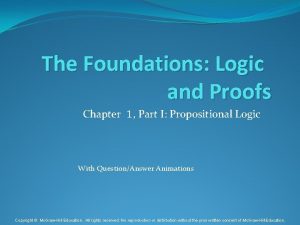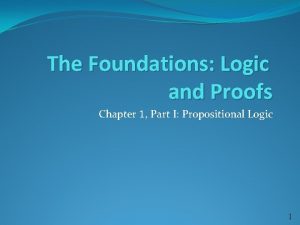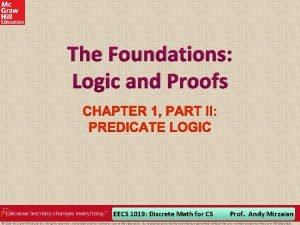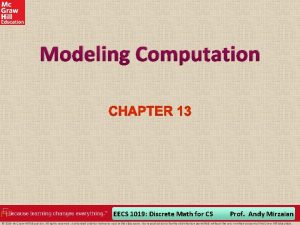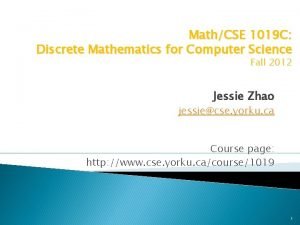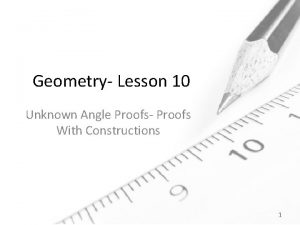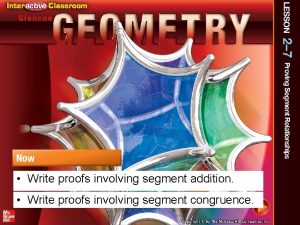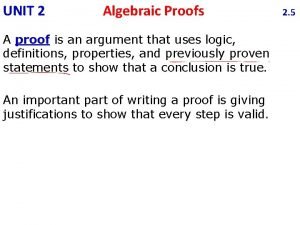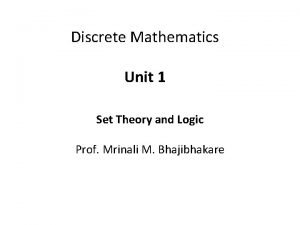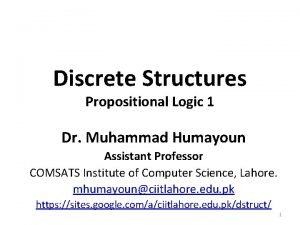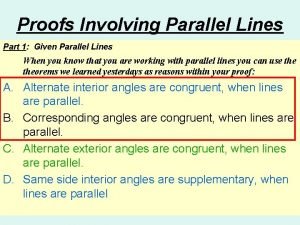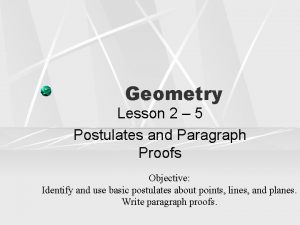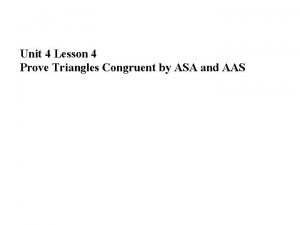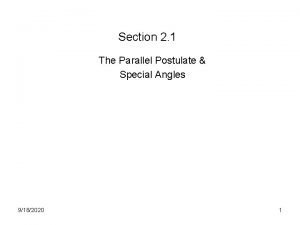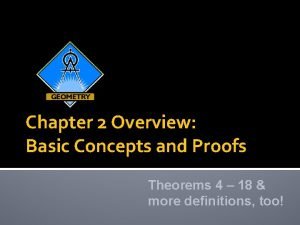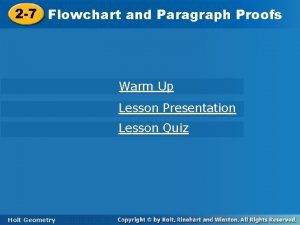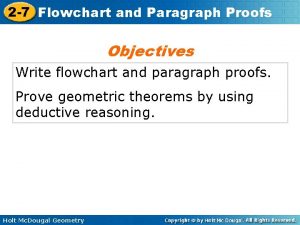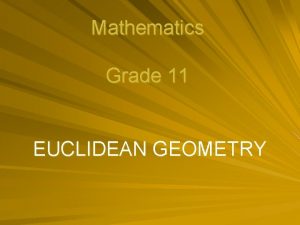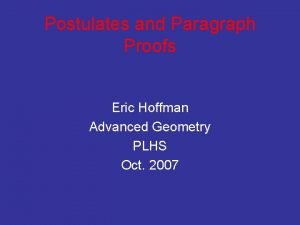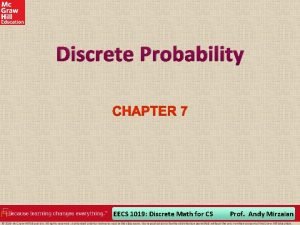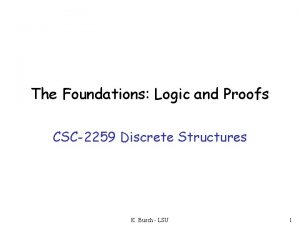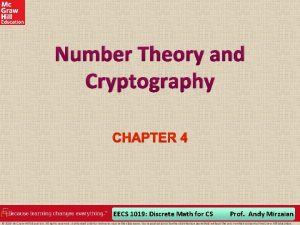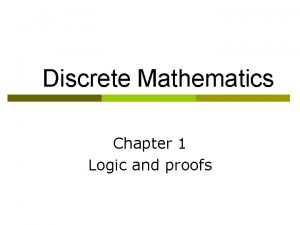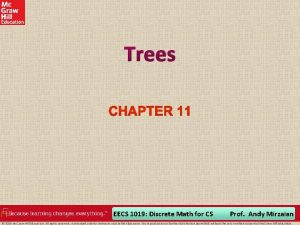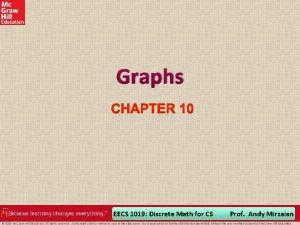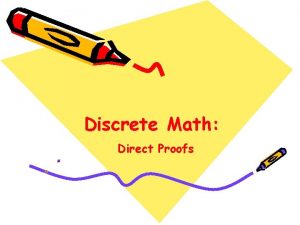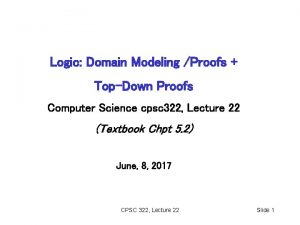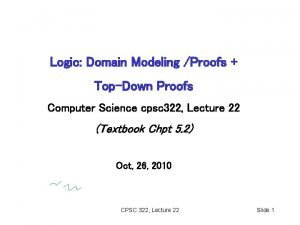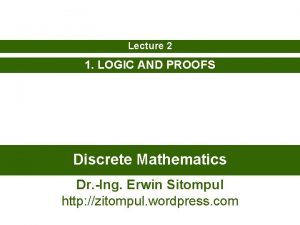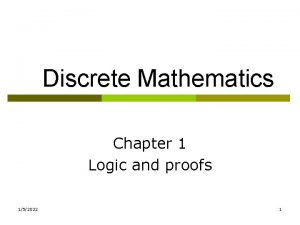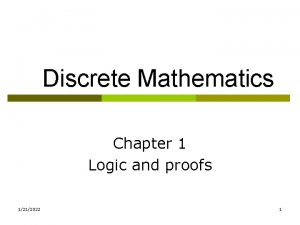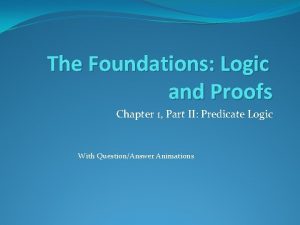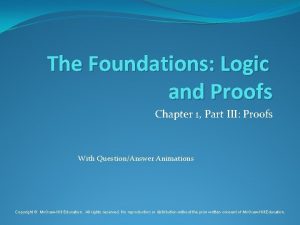The Foundations Logic and Proofs EECS 1019 Discrete






























































- Slides: 62

The Foundations: Logic and Proofs EECS 1019: Discrete Math for CS Prof. Andy Mirzaian © 2019 Mc. Graw-Hill Education. All rights reserved. Authorized only for instructor use in the classroom. No reproduction or further distribution permitted without the prior written consent of Mc. Graw-Hill Education.

Chapter Summary Propositional Logic (aka, Zeroth-Order Logic) • The Language of Propositions • Applications • Logical Equivalences Predicate Logic (aka, First-Order Logic) • The Language of Quantifiers • Logical Equivalences • Nested Quantifiers Proofs • Rules of Inference • Proof Methods • Proof Strategy © 2019 Mc. Graw-Hill Education 2

Propositional Logic Summary The Language of Propositions • Connectives • Truth Values • Truth Tables Applications • • Translating English Sentences System Specifications Logic Puzzles Logic Circuits Logical Equivalences • Important Equivalences • Showing Equivalence • Satisfiability © 2019 Mc. Graw-Hill Education 3

Propositional Logic Section 1. 1 Socrates (470 -399 BC) Plato (428 -348 BC) Aristotle (384 -322 BC) Philosophy Logic Gottfried Wilhelm von Leibniz (1646 -1716) Symbolic Logic George Boole (1815 -1864) Augustus De Morgan (1806 -1871) Boolean Algebra Relational & Universal Algebra 4 © 2019 Mc. Graw-Hill Education

Section Summary 1 Propositions Connectives • • • Negation Conjunction Disjunction Implication; contrapositive, inverse, converse Biconditional Truth Tables 5 © 2019 Mc. Graw-Hill Education

Propositions A proposition is a declarative sentence that is either true or false. Examples of propositions: a) b) c) d) e) The Moon is made of green cheese. Trenton is the capital of New Jersey. Toronto is the capital of Canada. 1 + 0 = 1 0 + 0 = 2 Examples that are not propositions. a) b) c) d) Sit down! What time is it? x + 1 = 2 x + y = z © 2019 Mc. Graw-Hill Education 6

Propositional Logic 7 © 2019 Mc. Graw-Hill Education

Compound Propositions: Negation The negation of a proposition p is denoted by ¬p and has this truth table: p T F ¬p F T Example: If p denotes “The earth is round. ”, then ¬p denotes “It is not the case that the earth is round, ” or more simply “The earth is not round. ” 8 © 2019 Mc. Graw-Hill Education

Conjunction The conjunction of propositions p and q is denoted by p ∧ q and has this truth table: p T T F F q T F p ∧ q T F F F Example: If p denotes “I am at home. ” and q denotes “It is raining. ” then p ∧ q denotes “I am at home and it is raining. ” © 2019 Mc. Graw-Hill Education 9

Disjunction The disjunction of propositions p and q is denoted by p ∨ q and has this truth table: p T T F F q T F p ∨ q T T T F Example: If p denotes “I am at home. ” and q denotes “It is raining. ” then p ∨ q denotes “I am at home or it is raining. ” © 2019 Mc. Graw-Hill Education 10

The Connective Or in English In English “or” has two distinct meanings. • “Inclusive Or” - In the sentence “Students who have taken CS 202 or Math 120 may take this class, ” we assume that students need to have taken one of the prerequisites, but may have taken both. This is the meaning of disjunction. For p ∨ q to be true, either one or both of p and q must be true. • “Exclusive Or” - When reading the sentence “Soup or salad comes with this entrée, ” we do not expect to be able to get both soup and salad. This is the meaning of Exclusive Or (Xor). In p ⊕ q , one of p and q must be true, but not both. The truth table for ⊕ is: © 2019 Mc. Graw-Hill Education p q p ⊕ q T T F T F T T F F F 11

Implication If p and q are propositions, then p q is a conditional statement or implication which is read as “if p, then q” and has this truth table: p T T F q T F T p q T F F T Example: If p denotes “I am at home. ” and q denotes “It is raining. ” then p q denotes “If I am at home then it is raining. ” In p q, p is the hypothesis (antecedent or premise) and q is the conclusion (or consequence). 12 © 2019 Mc. Graw-Hill Education

Understanding Implication 1 In p q there does not need to be any connection between the antecedent or the consequent. The “meaning” of p q depends only on the truth values of p and q. These implications are perfectly fine, but would not be used in ordinary English. • “If the moon is made of green cheese, then I have more money than Bill Gates. ” • “If the moon is made of green cheese, then I’m on welfare. ” • “If 1 + 1 = 3, then your grandma wears combat boots. ” 13 © 2019 Mc. Graw-Hill Education

Understanding Implication 2 One way to view the logical conditional is to think of an obligation or contract. • “If I am elected, then I will lower taxes. ” • “If you get 100% on the final, then you will get an A. ” If the politician is elected and does not lower taxes, then the voters can say that he or she has broken the campaign pledge. Something similar holds for the professor. This corresponds to the case where p is true and q is false. 14 © 2019 Mc. Graw-Hill Education

Different Ways of Expressing p q if p, then q p implies q if p, q p only if q q unless ¬p q when p q if p q whenever p p is sufficient for q q follows from p q is necessary for p a necessary condition for p is q a sufficient condition for q is p © 2019 Mc. Graw-Hill Education 15

Converse, Contrapositive, and Inverse From p q we can form new conditional statements. • q p is the converse of p q • ¬q ¬p is the contrapositive of p q • ¬p ¬q is the inverse of p q Example: Find the converse, inverse, and contrapositive of “It raining is a sufficient condition for my not going to town. ” Solution: converse: If I do not go to town, then it is raining. inverse: If it is not raining, then I will go to town. contrapositive: If I go to town, then it is not raining. 16 © 2019 Mc. Graw-Hill Education

Biconditional If p and q are propositions, then we can form the biconditional proposition p q, read as “p if and only if q. ” The biconditional p q denotes the proposition with this truth table: p T T F q T F T p q T F F T Example: If p denotes “I am at home. ” and q denotes “It is raining. ” then p q denotes “I am at home if and only if it is raining. ” © 2019 Mc. Graw-Hill Education 17

Expressing the Biconditional Some alternative ways that “p if and only if q” is expressed in English: • p is necessary and sufficient for q • if p then q, and conversely • p iff q 18 © 2019 Mc. Graw-Hill Education

Truth Tables For Compound Propositions Construction of a truth table: Rows • Need a row for every possible combination of values for the atomic propositions. Columns • Need a column for the compound proposition (usually at far right) • Need a column for the truth value of each expression that occurs in the compound proposition as it is built up. o This includes the atomic propositions © 2019 Mc. Graw-Hill Education 19

Example Truth Table Construct a truth table for p ∨ q ¬r p q r ¬r p∨q p ∨ q ¬r T T T F T T F T F T F F T T T F F F T 20 © 2019 Mc. Graw-Hill Education

Equivalent Propositions Two propositions are equivalent if they always have the same truth value. Example: Show using a truth table that the conditional is equivalent to the contrapositive. Solution: p T T F q T F T ¬p ¬q p q ¬q ¬p F F T F T T F F T T © 2019 Mc. Graw-Hill Education 21

Using a Truth Table to Show Non-Equivalence Example: Using truth table show that implication is not equivalent to its inverse nor to its converse. Solution: p T T F q T F T ¬p ¬q p q ¬p ¬q q p F F T F T T T F F F T T T 22 © 2019 Mc. Graw-Hill Education

Problem 23 © 2019 Mc. Graw-Hill Education

Precedence of Logical Operators Operator ¬ ∧ ∨ Precedence 1 2 3 4 5 p ∨ q ¬r is equivalent to (p ∨ q) ¬r If the intended meaning is p ∨(q ¬r) then parentheses must be used. 24 © 2019 Mc. Graw-Hill Education

Applications of Propositional Logic Section 1. 2 25 © 2019 Mc. Graw-Hill Education

Applications of Propositional Logic: Summary • Translating English to Propositional Logic • System Specifications • Boolean Searching • Logic Puzzles • Logic Circuits • AI Diagnosis Method (not covered) 26 © 2019 Mc. Graw-Hill Education

Translating English Sentences 27 © 2019 Mc. Graw-Hill Education

Example 28 © 2019 Mc. Graw-Hill Education

System Specifications 29 © 2019 Mc. Graw-Hill Education

Consistent System Specifications Definition: A list of propositions is consistent if it is possible to assign truth values to the proposition variables so that each proposition is true. Exercise: Are these specifications consistent? • • • “The diagnostic message is stored in the buffer or it is retransmitted. ” “The diagnostic message is not stored in the buffer. ” “If the diagnostic message is stored in the buffer, then it is retransmitted. ” Solution: Let p denote “The diagnostic message is stored in the buffer. ” Let q denote “The diagnostic message is retransmitted” The specification can be written as: p ∨ q, ¬p, p q. When p is false and q is true all three statements are true. So the specification is consistent. • What if “The diagnostic message is not retransmitted” is added. Solution: Now we are adding ¬q and there is no satisfying assignment. So the specification is not consistent. © 2019 Mc. Graw-Hill Education 30

Logic Puzzles Raymond Smullyan (1919 -2017) 31 © 2019 Mc. Graw-Hill Education

32 © 2019 Mc. Graw-Hill Education

Propositional Equivalences Section 1. 3 33 © 2019 Mc. Graw-Hill Education

Section Summary 2 Tautologies, Contradictions, Contingencies. Logical Equivalence • Important Logical Equivalences • Showing Logical Equivalence Normal Forms • Disjunctive Normal Form • Conjunctive Normal Form Propositional Satisfiability • Sudoku Example 34 © 2019 Mc. Graw-Hill Education

Tautologies, Contradictions, and Contingencies A tautology is a proposition which is always true. • Example: p ∨ ¬p A contradiction is a proposition which is always false. • Example: p ∧ ¬p A contingency is a proposition which is neither a tautology nor a contradiction, such as p P T F © 2019 Mc. Graw-Hill Education ¬p p ∨ ¬p p ∧ ¬p F T T T F F 35

Logically Equivalent Two compound propositions p and q are logically equivalent if p q is a tautology. We write this as p ⇔ q or as p ≡ q where p and q are compound propositions. Two compound propositions p and q are equivalent if and only if the columns in a truth table giving their truth values agree. This truth table shows that ¬p ∨ q is equivalent to p q. © 2019 Mc. Graw-Hill Education p T T F q T F T ¬p ¬p ∨ q F F T T F T p q T F F T T T 36

De Morgan’s Laws Augustus De Morgan 1806 -1871 This truth table shows that De Morgan’s Second Law holds. p T T F q T F T ¬p ¬q (p ∨ q) ¬p ∧ ¬q F F T F T T T F F F F T T 37 © 2019 Mc. Graw-Hill Education

Key Logical Equivalences 1 Identity Laws: Domination Laws: Idempotent laws: Double Negation Law: Negation Laws: 38 © 2019 Mc. Graw-Hill Education

Key Logical Equivalences 2 Commutative Laws: Associative Laws: Distributive Laws: 39 © 2019 Mc. Graw-Hill Education

More Logical Equivalences TABLE 7 Logical Equivalences Involving Conditional Statements. TABLE 8 Logical Equivalences Involving Biconditional Statements. 40 © 2019 Mc. Graw-Hill Education

Constructing New Logical Equivalences We can show that two expressions are logically equivalent by developing a series of logically equivalent statements. To prove that A ≡ B we produce a series of equivalences beginning with A and ending with B. Keep in mind that whenever a proposition (represented by a propositional variable) occurs in the equivalences listed earlier, it may be replaced by an arbitrarily complex compound proposition. 41 © 2019 Mc. Graw-Hill Education

Equivalence Proofs 1 Example: Show that is logically equivalent to Solution: by the second De Morgan law by the first De Morgan law by the double negation law by the second distributive law by the commutative law for disjunction by the identity law for F © 2019 Mc. Graw-Hill Education 42

Equivalence Proofs 2 Example: Show that is a tautology. Solution: by truth table for by the first De Morgan law by associative and commutative laws for disjunction by truth tables by the domination law 43 © 2019 Mc. Graw-Hill Education

How to prove a tautology Revisit this after Chapter 1 – Part 3 slides 44 © 2019 Mc. Graw-Hill Education

Digital Logic Gates NOT AND NOR NAND XOR § Some gates can be simulated by a combination of other gates. § Is there any single gate that can simulate all others? 45 © 2019 Mc. Graw-Hill Education

Digital Logic Circuits Out This circuit can be simplified to: 46 © 2019 Mc. Graw-Hill Education

Normal Forms 47 © 2019 Mc. Graw-Hill Education

Disjunctive Normal Form 1 48 © 2019 Mc. Graw-Hill Education

Disjunctive Normal Form 2 Example: Show that every compound proposition can be put in disjunctive normal form. Solution: Construct the truth table for the proposition. Then an equivalent proposition is the disjunction with n conjunctive clauses (where n is the number of rows for which the formula evaluates to T). Each clause has m literals where m is the number of distinct propositional variables. Each literal in that clause is the positive form of a variable if the variable is assigned T in that row, and in negative form if that variable is assigned F in that row. This proposition is in disjunctive normal from. 49 © 2019 Mc. Graw-Hill Education

Disjunctive Normal Form 3 ¬r p ∨ q ¬r p q r T T T F T T F T F T F F T T T F F F T 50 © 2019 Mc. Graw-Hill Education

Disjunctive Normal Form 3 ¬r p ∨ q ¬r p q r T T T F T T F T F T F F T T T F F F T © 2019 Mc. Graw-Hill Education 51

Conjunctive Normal Form 1 A compound proposition is in Conjunctive Normal Form (CNF) if it is a conjunction of disjunctive clauses. • Every proposition can be put in an equivalent CNF. • Conjunctive Normal Form (CNF) can be obtained by repeated application of equivalence laws such as: § eliminating implications, § moving negation inwards using De Morgan’s Laws, § applying distributive, associative, and other laws. • CNF is important in resolution theorem proving used in Artificial Intelligence (AI). 52 © 2019 Mc. Graw-Hill Education

Conjunctive Normal Form 2 53 © 2019 Mc. Graw-Hill Education

Propositional Satisfiability A compound proposition is satisfiable if there is an assignment of truth values to its variables that make it true. When no such assignments exist, the compound proposition is unsatisfiable. A compound proposition is unsatisfiable if and only if its negation is a tautology. 54 © 2019 Mc. Graw-Hill Education

Questions on Propositional Satisfiability 55 © 2019 Mc. Graw-Hill Education

Notation 56 © 2019 Mc. Graw-Hill Education

Sudoku A Sudoku puzzle is represented by a 9× 9 grid made up of nine 3× 3 subgrids, known as blocks. Some of the 81 cells of the puzzle are assigned one of the numbers 1, 2, …, 9. The puzzle is solved by assigning numbers to each blank cell so that every row, column and block contains each of the nine possible numbers. Example: 57 © 2019 Mc. Graw-Hill Education

Encoding as a Satisfiability Problem 1 Let p(i, j, n) denote the proposition that is true when the number n is in the cell in the ith row and the jth column. There are 9 × 9 = 729 such propositions. In the sample puzzle p(5, 1, 6) is true, but p(5, j, 6) is false for j = 2, 3, … 9 58 © 2019 Mc. Graw-Hill Education

Encoding as a Satisfiability Problem 2 59 © 2019 Mc. Graw-Hill Education

Encoding as a Satisfiability Problem 3 60 © 2019 Mc. Graw-Hill Education

Solving Satisfiability Problems To solve a Sudoku puzzle, we need to find an assignment of truth values to the 729 variables of the form p(i, j, n) that makes the conjunction of these assertions true. Those variables that are assigned T yield a solution to the puzzle. A truth table can always be used to determine the satisfiability of a compound proposition. But this is too complex even for modern computers for large problems. There has been much work on developing efficient methods for solving satisfiability problems as many practical problems can be translated into satisfiability problems. 61 © 2019 Mc. Graw-Hill Education

62 © 2019 Mc. Graw-Hill Education
 Idempotent law example
Idempotent law example The foundations logic and proofs
The foundations logic and proofs Nested quantifiers
Nested quantifiers Modeling computation discrete math
Modeling computation discrete math Eecs 1019
Eecs 1019 Lesson 10 unknown angle proofs
Lesson 10 unknown angle proofs Lesson 9 unknown angle proofs—writing proofs
Lesson 9 unknown angle proofs—writing proofs Segment addition postulate proofs
Segment addition postulate proofs Algebraic proofs practice
Algebraic proofs practice Discrete math set theory
Discrete math set theory Discrete math propositional logic
Discrete math propositional logic Application of propositional logic in discrete mathematics
Application of propositional logic in discrete mathematics Conditional proposition
Conditional proposition First order logic vs propositional logic
First order logic vs propositional logic First order logic vs propositional logic
First order logic vs propositional logic Third order logic
Third order logic Combinational logic vs sequential logic
Combinational logic vs sequential logic Cryptarithmetic problem logic+logic=prolog
Cryptarithmetic problem logic+logic=prolog Software development plan
Software development plan Is it x y or y x
Is it x y or y x Combinational logic sequential logic 차이
Combinational logic sequential logic 차이 Combinational logic sequential logic
Combinational logic sequential logic Proofs of work and bread pudding protocols
Proofs of work and bread pudding protocols Parallel lines proofs
Parallel lines proofs 2-5 homework postulates and paragraph proofs answers
2-5 homework postulates and paragraph proofs answers Unit 4 homework 5 proving triangles congruent answer key
Unit 4 homework 5 proving triangles congruent answer key Types of special angles
Types of special angles Chapter 2 basic concepts and proofs answers
Chapter 2 basic concepts and proofs answers A paragraph proof uses
A paragraph proof uses Flowchart proof
Flowchart proof Euclidean geometry grade 11 reasons
Euclidean geometry grade 11 reasons Advanced geometry proofs
Advanced geometry proofs Hình ảnh bộ gõ cơ thể búng tay
Hình ảnh bộ gõ cơ thể búng tay Frameset trong html5
Frameset trong html5 Bổ thể
Bổ thể Tỉ lệ cơ thể trẻ em
Tỉ lệ cơ thể trẻ em Voi kéo gỗ như thế nào
Voi kéo gỗ như thế nào Chụp tư thế worms-breton
Chụp tư thế worms-breton Chúa yêu trần thế
Chúa yêu trần thế Các môn thể thao bắt đầu bằng tiếng đua
Các môn thể thao bắt đầu bằng tiếng đua Thế nào là hệ số cao nhất
Thế nào là hệ số cao nhất Các châu lục và đại dương trên thế giới
Các châu lục và đại dương trên thế giới Công thức tiính động năng
Công thức tiính động năng Trời xanh đây là của chúng ta thể thơ
Trời xanh đây là của chúng ta thể thơ Mật thư anh em như thể tay chân
Mật thư anh em như thể tay chân Phép trừ bù
Phép trừ bù độ dài liên kết
độ dài liên kết Các châu lục và đại dương trên thế giới
Các châu lục và đại dương trên thế giới Thơ thất ngôn tứ tuyệt đường luật
Thơ thất ngôn tứ tuyệt đường luật Quá trình desamine hóa có thể tạo ra
Quá trình desamine hóa có thể tạo ra Một số thể thơ truyền thống
Một số thể thơ truyền thống Cái miệng nó xinh thế chỉ nói điều hay thôi
Cái miệng nó xinh thế chỉ nói điều hay thôi Vẽ hình chiếu vuông góc của vật thể sau
Vẽ hình chiếu vuông góc của vật thể sau Thế nào là sự mỏi cơ
Thế nào là sự mỏi cơ đặc điểm cơ thể của người tối cổ
đặc điểm cơ thể của người tối cổ V cc cc
V cc cc Vẽ hình chiếu đứng bằng cạnh của vật thể
Vẽ hình chiếu đứng bằng cạnh của vật thể Phối cảnh
Phối cảnh Thẻ vin
Thẻ vin đại từ thay thế
đại từ thay thế điện thế nghỉ
điện thế nghỉ Tư thế ngồi viết
Tư thế ngồi viết Diễn thế sinh thái là
Diễn thế sinh thái là
